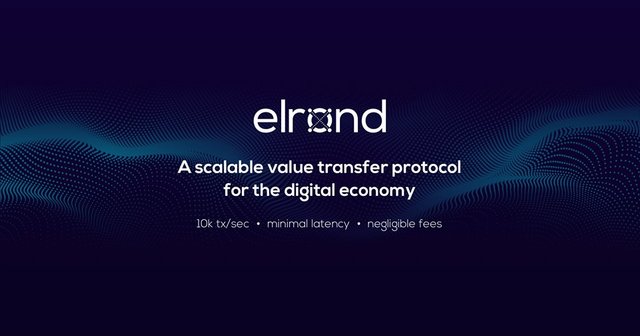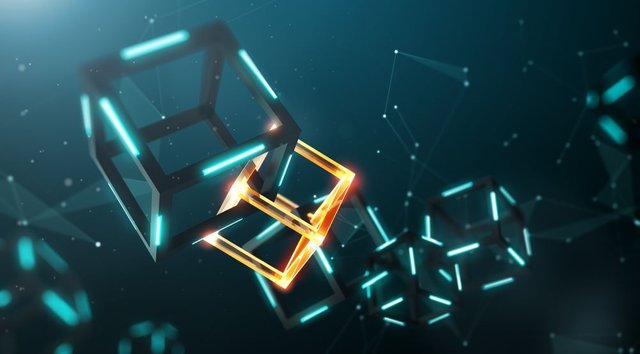Elrond - A scalable value transfer protocol for the digital economy

Despite the 10th anniversary, blockchain technology is still at the initial stages of its formation. For all these years, the practical application of the technology has not been found, crypto enthusiasts continue to overtake transactions between wallets and exchanges, trying to make money on it. In general, the blockchain technology, in addition to speculative interest, has not yet generated anything sensible, which would really be of interest to people and could modernize the long-obsolete centralized structures. All this is due to the fact that a solution has not yet been found that can solve the trillem of scalability.
V. Buterin wrote the scalability trilemma , according to which any Blockchain can have only 2 of 3 properties: scalability, decentralization, or security . All existing blockchains today sacrifice one of the indicators in favor of another, so the technology is still marking time. Bitcoin and Ethereum sacrificed scalability in favor of decentralization, they perform their function well only until the network is overloaded, and with the growth of the ecosystem, problems appear, such as the limited speed of transaction execution. Until transactions are carried out on a free scale - you can’t even dream about the massive use of blockchain technology. Elrond Network Project Team it understands perfectly and creates its own network, which will be devoid of the shortcomings of existing blockchains.
What is the Elrond Network?

Elrond Network is a project that is finally able to solve the scalability trilemma of blockchain networks and strengthen the interaction of technology with real sectors of the economy. The main objective of the Elrond Network is to create a new blockchain architecture that goes beyond the modern level and is designed for practical scalability using adaptive state separation and secure transaction confirmation (SPoS). In an ecosystem that seeks interconnectivity, their smart contract solution offers an EVM-compatible mechanism for interoperability by design. This is a guarantee that Elrond Network will be relevant in the ever-growing blockchain environment.
Elrond network - This is a complete rethinking of the public blockchain architecture, specially designed to provide overall overall improvement due to scalability, efficiency and security while maintaining a fairly decentralized setting. To achieve this goal, the team introduced a new adaptive state separation mechanism that provides scalability as more and more nodes join the network, paralyzing transaction processing. At the consensus level, Elrond offers a new mechanism called Secure Proof of Stake, introducing a random selection of the consensus group, a bet plus rate as a suitability function to prevent sibil attacks, and an almost instant pBFT-based finality. To provide decentralized applications, Elrond is designed to be compatible with EVM and Ewasm,
Product

To date, Elrond has made significant progress in developing its product. Thanks to the latest iteration of their network, completely rewritten in the language of the GO code, the team was able to achieve 3750+ TPS in one segment, which is a significant improvement since their prototype. This shows that the team is committed to its roadmap, ensuring continuous progress even before raising funds, and investors know in advance what they are investing in. Testnet is up and running successfully, and the early Elrond blockchain also has a convenient UX that will be available to the public in the next few months.
Competitiveness

Elrond Network's main competitors are EOS, Zilliqa, PChain and Quarkchain. All of these competitors are trying to solve scalability problems and offer solutions that provide high TPS throughput while maintaining appropriate levels of security. They also follow another beaten path between chains, which is also being addressed by many other projects such as Polkadot and PChain. There is every chance to beat your competitors by providing the crypto community and the whole world with a viable product that will take on the competition and integrate the network into the relevant blockchain infrastructure projects.
Potential Market Size
Elrond Network expects to become a major player in the so-called “big league” of blockchain development, which is a sector with high bandwidth, segmentation and interconnectivity. The need for high bandwidth and low cost of data storage is constantly high. A project that will solve these problems and provide an open and easily interacting chain will gain wide popularity, therefore this project has every chance to take a leading position.
Innovation and Intellectual Property
The position the team adheres to is an open source product that provides faster adoption levels and supports the principle of decentralization, so they made their prototype code available on their Github page.
Using blockchain
Blockchain technology is an integral part of the Elrond network project, it is the main goal of these projects, since it is aimed at expanding the infrastructure of blockchains with its new solution and providing fast, scalable and secure cryptocurrency and a network with high bandwidth.
Ecosystem tokens
The Elrond platform will use its own token called Elrond (ERD) . It will act as an inexpensive high-speed cryptocurrency that can be used to process various transactions. ERD functions will primarily manage the network, since secure stake proof requires that the nodes contain a significant amount of EDR in order to manage the network and the negotiation mechanism. Elrond Network will also use a master node system that will encourage EDR holders who deposit their coins to help confirm transactions and regulate the system.
Security measures

The Elrond Network uses an improved Proof of Stake consensus algorithm, called Secured Proof of Stake , in which consensus is reached by randomly selecting validators, determining the right to bid and rating with the optimal measurement for the consensus group. They use a random number consisting of several variable parameters to select nodes in a group of segments, thus preventing highly adaptive malicious attacks. After each era, 1/3 of the nodes from each shard are redistributed among other shards to further reduce the likelihood of malicious actions, and each node has a rating based on the honesty of its actions. The rating affects the likelihood of choosing a site in an agreed group.
Decentralization

The Elrond Network takes another step towards the decentralization of the Proof of Stake mechanism, adding randomness to it, thereby ensuring that nodes are redistributed evenly and non-deterministic among other segments. In addition, the network ensures that the consensus group is selected fairly based on the rating of nodes and other parameters that also guarantee randomness, and the signature of each block contains at least 2/3 + 1 signatures of the validator group, thus providing democratic control in consensus system.
As described above, reconfiguration of segments in eras and arbitrary choice of validators in rounds prevents the creation of unscrupulous groups, reduces the likelihood of DDoS attacks and bribery while maintaining decentralization and high transaction throughput.
Storage and mining
Elrond Network will operate based on a consistent protocol that belongs to the class of plexus-based protocols and is supported by the new Proof of Stake mechanism.
The storage problem is solved by the Elrond team due to the fact that a network with high bandwidth leads to a distributed register, which quickly grows in size and increases the cost of downloading (time + storage). Costs are taken into account in the Elrond solution using reduction algorithms that can summarize the complete state of the blockchain in a more compressed structure. The reduction mechanism is similar to the stable control points in pBFT and compresses the entire state of the register. The network is also starting to improve the Omniledger algorithm through an adaptive state separation approach, faster random selection of a consensus group, and increased security by replacing a set of validators after each round (a few seconds), and not after every day.
System delay due to permutation of nodes between segments is eliminated by distributing 1/3 of the validators to other segments, thereby ensuring a level of randomness and security, as well as the absence of temporary fines for network survivability. Elrond uses the Bellare and Neven multi-signature scheme, which eliminates one round of communication in the signature algorithm, since proof of ownership is not required, but a high level of security is still maintained.
The Elrond team offers a fast, secure and scalable blockchain network that can process 10,000 transactions per second and support a large number of dApp applications. Despite the great competition in this space, and all of them are aimed at creating high-bandwidth networks, by 2020 about 10,000 dApps will be involved and the blockchain industry will only contribute to mass introduction into the global economy and everyday life. What Elrond Network offers can significantly increase the value of the entire blockchain technology, using new protocols and consensus mechanisms and expanding boundaries. This, combined with the fact that one of the priorities of the Elrond Network is interoperability, allows the project to become a leading force in the development of blockchains.
Documentation

All project documentation is in perfect order. Key aspects are posted on the main project website, which anyone can see at any time. It describes in detail the architecture and levels of the Elrond network, presents their views on the development and adoption of the business, as well as a brief presentation of the team and consultants and a description of the roadmap.
The technical document is presented in the form of a 16-page document and is devoted exclusively to the technical aspects of the project, there I really didn’t understand anything really, but it was written professionally. The documentation briefly discusses the fact that Elrond Network is upgrading the entire blockchain technology, what are the problems of modern networks and how Elrond plans to solve them.
The white paper is intended for people with experience in technology, but it summarizes many important aspects of the network, even for non-technical audiences. In addition, this explains, first of all, the mechanism of consensus and separation, the cryptographic layer, as well as the space of the competitor. The documentation also addresses security and bootstrapping issues, as well as storage issues. The technical document is not exhaustive and does not contain information about the team, the sale of tokens, legal disclaimers or any potential business plan. A simple roadmap is available, but more information about the team is available on the website.
At the moment, the project has already updated a technical document consisting of a 16-page document with an emphasis on technical aspects. The new version of the document is more concise, structured and offers a broader approach to the presentation of the Elrond ecosystem. The key areas that have been improved relate to the paragraphs “Related work” and “Sharding”, which give a comparative look at the Elrond Network with the approaches of other networks. They also proposed new paragraphs that complement the already detailed document, which describes in detail the real problems faced by blockchain networks, the blockchain performance paradigm, and the group iteration of smart contracts and virtual machines.
Readability
The language used in the white paper is easy to understand and can be used by most readers. Although some key points are explained in detail, which is not so bad, a non-technical reader can catch up with these points with the help of generalized information, comparison with competitors' projects and a well-written conclusion. There are also a number of illustrations that help readers understand key points, and for the more technically advanced, the technical document contains a large number of links to more detailed studies.
The technical document does not contain any information about the team or any data on the sale of tokens; he focuses solely on technical solutions and project methodology. The website does an excellent job of introducing the team and consultants, but there is also no information about the sale of tokens. The team said that their main focus is on the delivery of the prototype and consideration of the details of the sale of tokens later, when they will have a work product to attract potential investors. The fact that they want to offer some type of product before raising funds from investors is a big plus.
Technology

The white paper discusses most of the technological aspects of the Elrond Network, explains the new consensus model, adaptive state separation mechanism, cryptographic level, boot and storage problems, and details the improvement or development of the network in terms of some aspects that can be found in competitors' projects. In addition, this document describes how security issues such as the Sybil attack, a fraudulent attack are addressed, how malicious behavior is prevented and confidentiality is achieved.
Road map

The project roadmap underlines not only the goals of the team, but also the important achievements of the project that were achieved in each respective period. The team also provided detailed information on activities related to business and network expansion plans, which we would like to learn more about, since these documents provide an idea of the team’s overall vision for network adoption.
The team proposed a detailed version of the roadmap for the first part of 2019, which addresses the start, basics, launch, and expansion of the Elrond Network. They divided the development of the network into two parts: the main ones, which represent a step forward in the development of the Elrond project, and the functions, which add value in combination with the main protocol, creating
In its latest version of the roadmap, the team highlighted the progress made by the Elrond network throughout 2019, delving into details and creating an ambitious time frame that addresses the development of a wide range of network features and options. Although we believe that the team has set very ambitious plans for the year, the team is constantly progressing and the transition to actual use cases, the functions carried out becomes a natural step to create a global product that can be adopted as an industry standard.
With the degree of detail presented by the current roadmap, the team shows that they are determined to provide a multi-functional product and fulfill all the requirements of a powerful blockchain network. The first two stages are included in the first quarter, which will be devoted to the launch of private and publicly available test networks, a round of financing, as well as stress testing and security audits to ensure the smooth development of the network. The third stage will take place in the 2nd and 3rd quarters with the launch of the main network, the exchange of tokens and the integration of Elrond with the payment provider to create a payment gateway. The last stage will begin in Q3-Q4 with the consolidation of the Mainnet network, the development of the Ecosystem fund and the integration of the network with digital cards. Along with these basic tasks, the team will complement a set of functions to complement the network and assist in the initial loading of the ecosystem, such as developing a private browser that will be integrated with Elrond, a desktop and mobile wallet, privacy mechanism, API + SDK. and many use cases for the platform. A private browser will also act as a more organic way to connect users to their blockchain, as Elrond will implement its own wallet that will use ERD tokens.
Business model
Another important step in the maturity of the project is its presence in the development and implementation of the business, as well as sections of the Elrond Ecosystem, which provide an idea of the main features of the project and provide a specific plan of action for the group regarding the expansion of the Elrond project from startup to small and medium-sized businesses. The team included a number of very important tasks in the business plan and was already able to implement some of them by establishing an appropriate partnership with the payment provider, thereby providing the first option for using the platform.
Update- With the further growth of the network, the team announced a new partnership with the Laboratory for Distributed System Research in the academic environment and hopes to expand the scope of projects to study the most basic problems and areas of applicability of blockchain technology and also explore the possibility of using the Elrond platform for decentralized management of the demand response program in smart grids .
There is no information on the display about the actual business model, about how the project will be used, about potential partnerships or any plans for using the network in real conditions. However, the team compares how different systems, centralized and decentralized, work in an environment where data storage and bootstrapping have resulted in the current blockchain architectures operating unexpectedly with bandwidth at the Visa level, so they aim to push the network to the highest level, that is, partnerships are possible with operators who need high bandwidth for their applications.
Cost effectiveness
At the moment, cost-effectiveness cannot be determined, since the team has not yet released any information about the token economy, but they compare themselves with projects whose cost varies from $ 50 billion (Eth) to $ 650 million (Zilliqa) , $ 4 million (Algorand) and work in the same spectrum of blockchain development as EOS ($ 10 billion valuation), Hashgraph ($ 300 million growth), Thunder ($ 100 million valuation), Kadena (growth by 12 million dollars), therefore, it is expected that the evaluation of the project will be at least 50 dollars. million. It is not yet clear how the Elrond team will determine the actual financial needs for the project and how revenue will be generated from the use of the platform.
Update- with the first version of the slide group, the team provided detailed information about the token economy, setting a hard limit of $ 15.2 million. US for 55% of tokens, creating an estimate of 27.6 million. United States, which compared with competitors' estimates is much lower. , We believe that their strict restriction will not be satisfied with these bearish sentiments in the market, however, 15.2 million are required for Elrond to become a stable company with a revenue stream.
Update 2- Several scenarios provided by the team and defining the latter approach with a significant reduction in hardcaps of $ 5 million for 40% of tokens creating an estimate of $ 12.5 million set the standard for the development of protocols and networks regarding mass valuation. from competitors. This suggests that the team will rather reissue and have organic growth based on demand, rather than not supplying and risking the future development of the project, and we like it.
Legitimacy
Due to the so far uncertain status of cryptocurrencies and a strong regulatory policy regarding blockchain technology and cryptocurrencies throughout the EU, especially with Switzerland, the Elrond Network team decided to register Elrond Ltd. at St. Julians in Malta - company number C88751.
Team

The Elrond team consists of 3 founding members and 8 members, and in addition, there are currently 3 advisers on the board of directors. The team seeks to recruit more team members and expand their positions in development, marketing and business. There is a good set of technical, commercial, legal and marketing knowledge, but the team will benefit from additional marketing efforts.
Update- To keep up with the fast pace of network development, the Elrond team has expanded to 17 members, adding new software developers and researchers, as well as marketing and UI / UX specialists, thereby improving the overall skillset available. Currently, the team is starting to focus on the marketing side of the project, as Elrond is approaching the token sale and product release phase.
Stages
According to the site, work on the project began in the third quarter of 2017, when preliminary technical work was carried out. No other information was provided, except that in 2018 the company was founded in Zug, Switzerland. All participants and consultants have LinkedIn profiles that can be easily verified, but it is difficult to evaluate the structure of the project company.
Founders
Beniamin Minku is the founder and CEO of Elrond. He had an early experience working with cryptocurrencies, he was an early investor in Bitcoin and a member of the core business group of the NEM project, where he joined them in 2014, managing business, marketing and community work. After leaving the NEM project, he began to help projects such as Zilliqa, Polkadot, Icon, Matrix, develop their business efforts. He is also the CEO and founder of ICO Market Data, an ICO valuation platform, and Metachain Capital, which has invested in one of the best projects on the market (ICON, Zilliqa, Wanchain, Polkadot, Matrix, PChain).
Advisory Board
The Advisory Board consists of 3 advisors who have extensive experience in relevant areas.
Alex Iskoldis a serial entrepreneur and investor with extensive experience in software development, he has invested in more than 90 startups and founded a number of companies.Patrick Storcheneggeris a Swiss lawyer who is part of the Ethereum Foundation. He has many years of experience in international tax law, corporate law, commercial law and capital market law.Andrei Pitisis vice president of engineering and head of the Bucharest office at Fitbit. Founder and CEO of Vector Watch. Angel Investor with several technical leadership positions. In general, the advisory board has relevant experience and should help Elron build partnerships and accelerate business development.
Update- Elrond welcomed 4 new advisors to its team to help the founding team take the company to the next level. The following advisors have been added to the team:
Alex Tabarrock- Alex is a co-founder of the University of the Marginal Revolution: an online platform for studying economics. He is the author of numerous scientific works in the field of law and economics, criminology, regulatory policy, voting theory and other areas of political economy. His academic background and impressive skill set are a great addition to his current team.Fabio Canesinis a co-founder of City of Zion, an independent global group of open source developers, designers and translators, created to support the core and ecosystem of NEO. Fabio is also a co-founder of NEX, a platform for creating sophisticated decentralized cryptographic trading and payment services. This is the one who can really draw attention to the project, and Elrond’s successful efforts to establish such a partnership bring the team much more trust and trust.Ethan Fastis the co-founder of City of Zion and Neon Exchange and the creator of NEO's most popular wallet, Neon Wallet. He is an entrepreneur and researcher with experience in the field of human-computer interaction, artificial intelligence and blockchain.Raul Jordanis the main developer of Ethereum. He is co-leader of Prysmatic Labs, the first implementation of Sharding for the Ethereum protocol. Raul is a partner at zk Capital, a research-oriented blockchain investment fund, and is a co-founder of Kynplex, the first-ever life science network that brings together online science innovation centers.
This is a great update from the team, and it demonstrates that they did not stagnate when the hype gathered for Elrond, but they did the opposite and used this effect to bring on board very important people with lots of skills. This strategic step will not only help Elrond Network get more information from investors and cryptocurrency communities, but in the long run it will increase the team's ability to establish partnerships and expand their reach.
Update 2- The team has stepped up its efforts to gather the best minds in space to help develop the project. Their latest adviser, Sunny Aggarwal , joined the Elrond advisory council, sharing his experience as the lead developer for Tendermint / Cosmos projects and as one of the co-founders of the Berchley Blockchain research group.
Update 3- As the team constantly ensures the progress of the Elrond Network, they often interact with their consultants who help launch the project, and therefore they suspended their collaboration with Sunny Aggarwal because he is focused on development. from Tendermit / Cosmos and cannot currently offer his experience for the Elrond network.
The Elrond team has several well-known and talented developers who have many years of experience in a number of areas directly related to software development.
Sebastian Marian is a leading developer with over 15 years of experience in programming and developing applications with languages from C, C ++, Visual C ++ to HTML, Java Script, SQL, ABAP, SAP.
Update- due to the rapidly changing nature of the industry, the team has adapted and shaped its sizes and roles to better match the development and growth of the project. With the growth of the team to 18 people, several positions were changed for a more structured approach to development, so team members such as Felix Krisan, Radu Chis and Adrian Dobrita took up the leadership positions of the Heads of Research, Heads of Technology and Head of Technology, respectively. They boast an impressive array of skills related to software development and research, and even publish scientific articles, several scientific papers, and prestigious journals.
Although the team mainly specializes in technology, they have several members who stand out in the field of business and marketing, such as Lucian Todea , who is a serial entrepreneur with active investments in the blockchain space and more than 15 years of experience in the field of technology. He is the founder, CEO, and angel investor in a series of fast-growing technology startups. From the whole Beniamin Mincu team has the most extensive experience with blockchains. He has invested and managed a wide range of positions for blockchain projects that are relatively successful. He is also the CEO and founder of Metachain Capital, a successful investment fund with a large portfolio of star projects in its portfolio.
Legal Counsel
Elrond’s Advisory Board also includes Patrick Storchenegger . He is part of the Ethereum Foundation legal group in Switzerland and advises a number of international companies, including those involved in trade, reinsurance, transportation and blockchain technologies. Patrick will ensure that the legal aspects are taken into account and that the project remains legally compatible.
Token sale
IEO at Binance was successful and on the listing the project reached 13x in USD, just phenomenal! But in addition, Binance Labs was an investor in the Elrond project at the private sale stage, which definitely gives him support from Binance, and also distinguishes it from similar projects, because Binance Labs searches and analyzes the market in search of real gems in order to invest in them, projects go through a truly rigorous selection process. In addition, such well-known organizations as Electric Capital, NGC Partners, Maven 11 and Woodstock became investors of Elrond.
Conclusion

I have no doubt that the team creates an outstanding product that is able to modernize the entire blockchain industry and make technology accessible to every inhabitant of the planet. The project has a highly qualified team, reliable partners and a finished product, but their competitors are not hamsters, so the Elrond Network team needs to move very quickly in order to take its place in this competitive field. In general, the project is quite interesting and may well become the best blockchain in the world. For a more detailed acquaintance with the project, click on the links below.
WEBSITE
WHITEPAPER
ANN
TELEGRAM
TWITTER
FACEBOOK
MEDIUM
Author
Telegram username: @cryptocat15